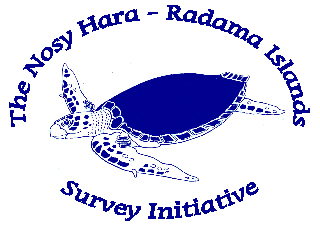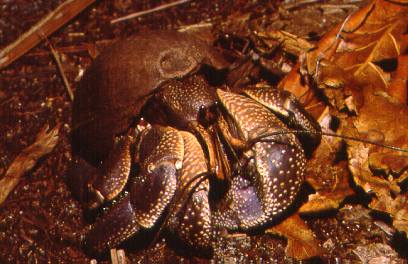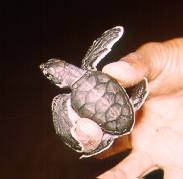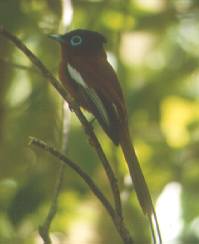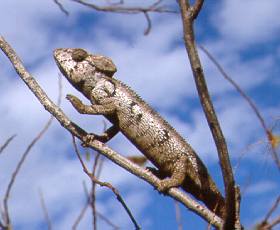Would you like to make this site your homepage? It's fast and easy...
Yes, Please make this my home page!
Nosy Hara and the Radama Islands, Madagascar
The Nosy Hara archipelago is a group of 12 uninhabited islands off the Northern
coast of Madagascar. All are of unique Malagsy 'tsingy' ecotype, made up of
cliffs and crags of weathered limestone. All our surrounded by pristine coral
reefs. Four of the islands, Nosy Hara, Nosy Lakandava, Nosy Anjombovola, and
Nosy Andranzara, have forest as well, growing up and upon the cliffs and crags,
and inhabited by endemic birds, frogs and lizards.
On
the largest island, Nosy Hara, during the day the unusual bright green diurnal
Malagasy gecko Phelsuma, is abundant on large tree trunks. At night,
a species of the fishscale gecko, Geckolepis can be found at the base of trees.
If frightened or handled, it can lose not only its tail, but also all its scales.
A large and potentially new species of the Homopholis genus was found
during both day and night, on large trees, or in cracks between the rocks. We
nicknamed it the dinosaur, from its size and its viciousness. Most exciting
of all, along the base of a dry streambed on Nosy Hara, we discovered a beautiful
bright blue lizard with a red throat. This species is being described by Achille
Raselimanana, from WWF Madagascar.

Birds
in the area include such representatives as the Malagasy paradise fly-catcher,
large Green Pigeons, small Button Quails and many more within the forests. Along
the coast and the cliffs, the rare endemic fishing eagle, Halieutees vociferoides
can occasionally be seen, as well as such species as the dimorphic egret and
the Gray Heron. In December, tens of thousands of graceful Sooty Terns flock
to nest on the islands of Nosy Vaha and Nosy Fotsy. Local people can collect
as many as 8000 eggs in a day, which they take to sell in nearest town of Diego.
On Nosy Fotsy, possibly as a result, this year the birds failed to appear.
Site content © Nosy Hara-
Radama Island Survey Initiative 2001
Site design by mampam.com
Two
lemur species are found on Nosy Hara, but it is unclear whether these were introduced
at a later date, or are endemic to the island. Finally, on Nosy Hara, a species
of the brightly colored Malagasy poison-arrow frog genus, Mantella was discovered
on our very last day on the island.
Finally, although the terrestrial biology of the islands is without a doubt
exceptional, there is little question that the marine biology is even better.
The WWF Marine Programme Advisor described the coral reefs as representing some
of the highest biodiversity he had ever seen. We regularly saw Hawksbill turtles
browsing amidst the coral, and between the islands, often came across dolphins.
The fishermen speak of regularly siting whales, and there are even rumors of
dugongs off Nosy Hara. Although we were unable to obtain any hard data on the
marine ecosystem, we can say without a doubt that further research is urgently
needed. High levels of exploitation of marine resources investigated through
the Community Survey suggest also that the importance of the implementation
of conservation measures is pressing.
Although
we had not the expertise to explore it, the flora seemed as exceptional as the
fauna, with baobabs, and pachypodiums, bizarre succulents clinging to the rock
faces, and large pungent flowers. At the start of the rainy season in December,
bright patches of colour burst out of the green canopy, splashing it with red
and purple.
From September to January 2000, we camped for five to ten day intervals on
each island to investigate the terrestrial fauna. Throughout the islands,
and on the associated mainland, we tried to identify all species present.
We used transect based methodologies in order to also be able to obtain indices
of relative abundance of the different species. This allows between-site comparison,
in many cases helping to show up the richness of the islands in comparison
with the mainland. This may help highlight the importance and value of conservation
in this area. Various ecological data and habitat correlates were also collected.
All data on the terrestrial ecology was collected within the framework of
the Degré d'Etudes Avancés of Rivo Andrianirina of the Université d'Antananarivo.
Local
people do use the islands for temporary camping sites in the course of their
fishing trips. However, it is fady, or taboo to kill or take anything off
the islands. In combination with the inaccessibility of the sites, this may
explain the uniquely pristine state of these islands. (Unfortunately, turtles
are not included in the prohibition).
In recent years, however, given the high value of sea-cucumbers (sold for the
Asian aphrodisiac market) escalating degrees of deforestation is being carried
out on almost all beaches in spite of the fady. Wood fires are used in the preparation
of sea cucumbers, which is done on the islands between convenient tides. Although
deforestation is insignificant as yet, it is only a matter of time before this
becomes a real issue. The sooty terns also are gravely threatened by current
egg-harvesting activities.



Site content © Nosy Hara- Radama
Island Survey Initiative 2001
Site design by mampam.com
